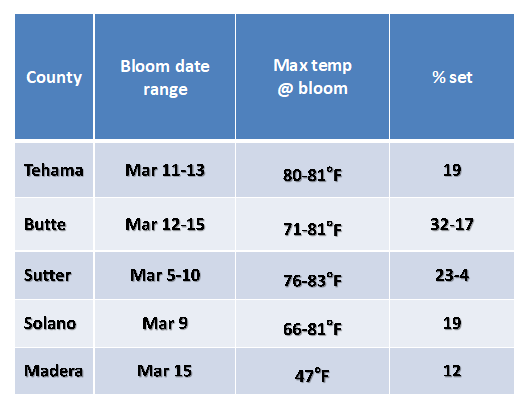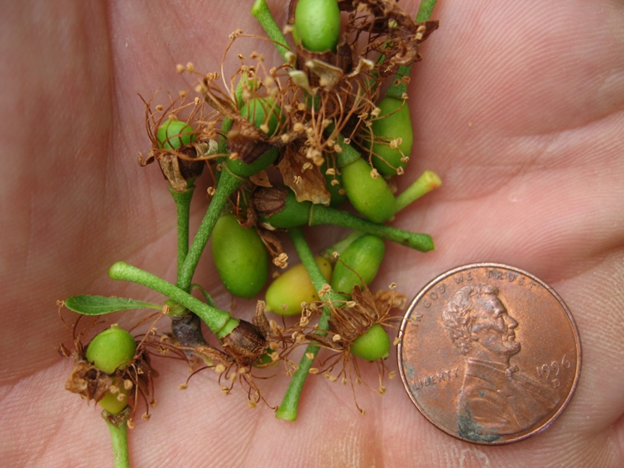Luke Milliron, UCCE Orchards Advisor, Butte, Glenn & Tehama
Franz Niederholzer, UCCE Orchards Advisor Colusa, & Sutter/Yuba
Kat Jarvis-Shean, UCCE Orchards Advisor Yolo, Solano, and Sacramento
Phoebe Gordon, UCCE Orchards Advisor Madera and Merced
Ideally prune trees would produce a good crop of large fruit each year that required no thinning. This ideal is created when trees have a lot of flower and only 15-20% of flowers become fruit that remain on the tree until harvest. However, this goldilocks fruit set percentage has not occurred across the industry in many years. In a typical year, good fruit set conditions lead to fruit set percentages closer to 30% or above, to achieve good fruit size that will be valued by handlers, growers then need to shaker thin near reference date. However, in a significant minority of years, there are local or statewide crop failures produced by poor bloom weather, in these years the percentage set is well below 15%. Although, the need to shaker thin, and the process of deleting fruit from the tree is a painful experience for growers, it is much better than having low set!
What are the lines between good and bad prune set bloom weather?
UCCE orchard advisors, led by Franz Niederholzer with support from the Prune Board, have been monitoring bloom weather and subsequent set for many years. The 2020 season helped refine some of the earlier learned lessons about prune bloom weather and subsequent fruit set. We have known for a long time that heat at around full bloom (80% flowers open) can lead to a crop failure. We thought that temperatures at and above 80 ⁰F could cook the ovule (when fertilized by the pollen can become the seed) and would lead to a crop failure. We now think that threshold at and above which crop failure will occur if max temperatures occur at full bloom or just after is at or above 83 ⁰F. On the opposite end of full bloom conditions, we also associate crop failures with prolonged cool and wet bloom periods with maximum temperatures below 60 ⁰F. The 2020 bloom season offered us examples at both extremes.
The 2020 prune bloom and crop set monitoring carried out by UCCE farm advisors showed dramatic differences in the prune set between different prune production regions (table 1). Again, prune set between 15 and 20 percent is the approximate sweet spot where great fruit size can be achieved without fruit thinning. In the monitoring by UCCE some orchards in Tehama, Butte, and Solano, some orchards appeared to land in this sweet spot range. Some of the orchard regions monitored had poor sets. Other orchards in these same regions had above 20% set and required shaker thinning to achieve adequate fruit size. In Sutter some orchards that had previously received a horticultural oil application bloomed earlier (March 5th) and experienced good bloom weather and high fruit set (23%). However, some orchards in Sutter that did not receive oil and reached full bloom closer to the middle of March experienced temperatures as high as 83 ⁰F right at or one to five days after full bloom and had crop failures, with set as low as 5%. Madera bloom temperatures were much cooler than in the Sacramento Valley and the poor fruit set in that area appears to be due to this prolonged cool weather.
There remain mysteries regarding the impact of bloom weather on crop set that we are continuing to investigate. Some of the wild cards that we do not understand are the full impacts of low humidity, saturated soil, and/or the length of bloom. Also, in 2020, growers reported that some trees had highly variable crop set within the canopy, and highly variable crop set between blocks that should have experienced very similar bloom weather. Researchers will continue to investigate the critical topic of bloom weather and crop management.

Table 1. Bloom timing, maximum temperatures at full bloom and percent fruit set in UC monitored prune orchards in 2020.



Leave a Reply